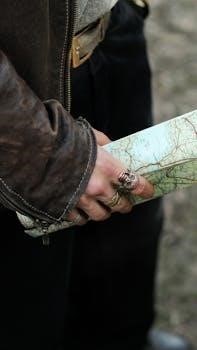Determining the correct ring size, especially when dealing with centimeters, is crucial for a comfortable and secure fit. This guide introduces the importance of precise measurements, ensuring your ring fits perfectly.
Importance of Accurate Ring Size
An accurate ring size is paramount for both comfort and security. A ring that’s too tight can cause discomfort, restrict circulation, and even be difficult to remove. Conversely, a ring that’s too loose risks slipping off and being lost. Precise measurement, especially when using centimeters, ensures your ring fits perfectly, avoiding these issues. When purchasing online or gifting, accuracy is even more vital as you can’t try the ring on beforehand. Using a reliable ring size guide, particularly one that incorporates centimeter measurements, will help you choose the right size. This ensures the ring will not only look great but also feel comfortable and remain safely on your finger. Accurate sizing prevents unnecessary adjustments, returns, and disappointments. Therefore, taking the time to measure correctly is essential for a satisfactory ring-wearing experience.

Methods for Measuring Ring Size
Several methods exist for measuring ring size, including using a chart, string or paper, and specialized tools. Each method offers a way to find the correct fit.
Using a Ring Size Chart
A ring size chart is a common method for determining your ring size. These charts usually include circles of various sizes, each corresponding to a specific ring size. To use a chart effectively, place an existing ring on top of the circles, matching the inner circumference of your ring to the closest circle on the chart. If you don’t have a ring, you can measure your finger using string or paper, then compare that measurement to the chart. Remember, accuracy is key, so ensure that your measurements align as closely as possible to the chart for the best fit. Many charts include measurements in both centimeters and inches, providing a versatile way to find the perfect ring size.
Measuring with String or Paper
If you don’t have a ring sizer, measuring with string or paper is a simple alternative. Cut a thin strip of paper or a piece of string, approximately 10 centimeters long. Wrap it snugly around the base of the finger where you plan to wear the ring, marking the point where the string or paper overlaps. Then, measure the length from the start of the string to your marked point using a ruler in centimeters. This measurement is the circumference of your finger, which you can then compare to a ring size chart to find your corresponding ring size. Be sure not to pull too tight or too loose for a comfortable fit.
Using a Ring Sizer Tool
A ring sizer tool is a convenient device for accurately determining your ring size. These tools, often made of plastic, typically feature a series of different sized rings or a sliding mechanism that can measure the circumference of your finger directly. To use a ring sizer, simply slide it onto your finger and adjust it until it fits comfortably, like a ring. The tool will then indicate your ring size, either through a number or letter corresponding to a specific size. Some ring sizers also provide measurements in centimeters, making it easier to find your exact size. This method is both reusable and highly reliable.

Ring Size Conversion
Ring size conversion is essential when dealing with different sizing systems. Understanding how to convert centimeters to various ring sizes ensures accurate fitting, regardless of the standard.
Centimeters to Ring Size Conversion
Converting centimeters (cm) to ring sizes is a fundamental skill for anyone purchasing jewelry online or from international sources. This conversion involves understanding that the circumference of your finger, measured in centimeters, directly correlates to a specific ring size. For example, a finger circumference of 5.4 cm typically corresponds to a European size 54. Using a reliable ring size chart is crucial, as these charts provide the necessary cm-to-ring size conversions. Online tools and calculators can also assist in this conversion process, ensuring accurate results. It’s important to note that slight variations in measurement can impact the ring size, so precise measuring is recommended. Remember that different countries may use different sizing systems, so knowing the cm measurement allows for accurate conversions across these systems.
International Ring Size Conversion
Navigating international ring sizes can be complex, as different countries use varying sizing standards. Understanding how to convert ring sizes across different systems is crucial, especially when purchasing jewelry from overseas. For instance, a ring size in the US differs from one in the UK, Europe, or Japan. Centimeter measurements, however, provide a common basis for these conversions. By knowing the circumference of your finger in centimeters, you can use conversion charts to find your corresponding size in another country’s system. Online tools are available that help convert cm measurements to various international ring sizes, ensuring you purchase the correct size. These conversions are vital to avoid inaccurate orders and ensure a perfect fit. Remember, using the cm as a universal measurement will help you translate across different ring sizing standards.

Ring Size Charts
Ring size charts are essential tools for accurately determining your ring size. They often include measurements in centimeters alongside corresponding ring sizes, aiding in finding the perfect fit.
Comprehensive Ring Size Chart with cm
A comprehensive ring size chart utilizing centimeters is a vital resource for anyone purchasing rings, especially online or when dealing with international sizing. These charts display finger circumferences in centimeters alongside corresponding ring sizes, often including US, UK, and European standards. For example, a finger circumference of 5.4 cm might correspond to a size 54 in European sizing. These detailed charts allow users to directly match their finger measurements in cm to the appropriate ring size, ensuring a snug yet comfortable fit. It’s essential to use a reliable chart, as slight variations in measurements can lead to an ill-fitting ring. Moreover, some charts provide diameter measurements in addition to circumference, enhancing accuracy. Always double-check the specific chart’s conversion details before making a final purchase or decision.
Different Sizing Systems and cm
Understanding different ring sizing systems is crucial when dealing with centimeter measurements, as various countries use distinct standards. While some systems directly correlate with finger circumference in cm, others may require conversions. For instance, European sizes often directly reflect the finger circumference in millimeters, which is easily convertible to centimeters (e.g., 54mm is 5.4cm). Conversely, US and UK sizing use numerical and alphabetical scales, respectively, requiring a conversion chart to find equivalent cm measurements. When a ring is described by size 7,8,9,10 or by letters, you can convert it to the circumference in centimeters, using ring conversion chart. Therefore, a detailed chart is essential to avoid errors and to make a correct choice. Always check the specific conversion details for each system to ensure accurate ring sizing.

Additional Tips
For a comfortable fit, measure your finger at the end of the day when it’s warmest. Consider knuckle size, ensuring the ring can pass easily, and avoid measuring when cold.
Measuring for a Comfortable Fit
Achieving a comfortable ring fit involves more than just knowing the circumference of your finger; timing and environment also play significant roles. It’s best to measure your finger at the end of the day when it is typically at its largest due to natural swelling. Avoid measuring when your hands are cold, as this can lead to an inaccurate, smaller size. Consider your knuckle size; the ring should slide over it easily but not be too loose. Remember that your finger size can change throughout the day and even over time, so multiple measurements may be beneficial. A ring should fit snugly, not so tight it restricts circulation, nor so loose that it spins or slips off easily. Proper fit ensures both comfort and security, preventing loss and discomfort during daily wear. Using these techniques allows for a more precise fit.
